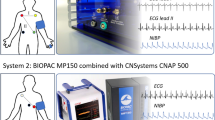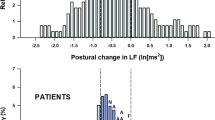Abstract
We analyzed long period of time (more than 10 h) autonomic nervous system data of 128 subjects (78 males and 50 females in 20’s, 30’s, 40’s and 50’s respectively) by using small wearable heart rate sensors. As a result, we found that there was a significant negative correlation (p value < 0.05) between LnTP (Total-Power as an indicator of comprehensive autonomic nervous system activity) and age for both sexes (genders). Moreover, the negative correlation value for male was higher than for female. The noticeable difference from the preceding study is that our research was based on data measured by many advanced wearable heart rate sensors which enabled to accumulate long period of time data in our daily life for many subjects and that we found the similar correlation between TP and aging comparing to the preceding study.
Access provided by Autonomous University of Puebla. Download conference paper PDF
Similar content being viewed by others
Keywords
1 Introduction
It’s been said for a long time that the current society is very stressful. It’s emerged that human being is prone to loss of health due to the damage on the autonomic nervous system and endocrine system such as adrenocortical hormone, being subject to many stressors for long period [1]. It’s been considered that the autonomic nervous system controls human being’s body by adjusting both sympathetic nerve activity, which is a barometer of tense or excitement, and parasympathetic nerve activity, which is a barometer of relaxation and by bringing the balance of sympathetic nerve activity and parasympathetic nerve activity. However, some reports reveal that the balance between sympathetic nerve activity and parasympathetic nerve activity changes with aging [2]. Human being’s internal environment, such as body temperature, blood pressure, and blood glucose level, is kept stable by so called “homeostasis”; however, due to the unbalanced autonomic nerve activity with aging, it’s hard for human being to take an appropriate action to external environment changes. For instance, the reason why it takes longer time with aging to get back to the normal heart rate after taking exercise is due to the declining parasympathetic nerve activity.
Some reports reveal that in case of female the parasympathetic nerve activity declines slowly with aging [3] and in case of male the sympathetic nerve activity is getting dominant with aging [4] but most of the reports depend on short-time measuring of autonomic nervous system.
In our research, we used small wearable heart rate sensor which enables to measure the autonomic nervous system activity for long period of time by taking into account circadian variation and tried to reveal whether we could get different result from previous research regarding the age-related change of the autonomic nervous system by sexes (genders).
2 Purpose
The purpose of this research is to verify whether the age or the sex effects on the autonomic nervous system activity by using small wearable heart rate sensor, which enables to measure the autonomic nervous system activity for long period of time in our daily life. Conventionally, 2–3 min measurement using the acceleration pulse wave sensor is the main way of autonomic nervous system research. It is relatively easy to collect a lot of data for a short period. However, we collected 128 subjects’ long time data (more than 10 h for each subject) and analyzed them.
3 Methods
We analyzed long period of time autonomic nervous system data of 128 subjects (78 males and 50 females in 20’s, 30’s, 40’s and 50’s respectively) by using the small wearable heart rate sensor manufactured by Union Tool Co (Fig. 1). This heart rate sensor enables to measure RR interval, body surface temperature and a value of triaxial acceleration.
The sampling frequency for RR interval, body surface temperature and triaxial acceleration is 1000 Hz, 1 Hz and 31.25 Hz respectively.
Table 1 below shows range of subjects’ sex (gender) and the age.
We made the frequency analysis of measured RR interval by Fast Fourier Transform, defining 0.04 Hz to 0.15 Hz as low frequency component (LF) and 0.15 Hz to 0.4 Hz as high frequency component (HF). The sum of LF and HF is called Total-Power (TP) and defined as an indicator of comprehensive autonomic nervous system activity. The abovementioned calculation method of autonomic nervous system is subject to the method defined in the research report [3]. Incidentally, it’s been reported that the TP of autonomic nervous system activity correlates to the level of fatigue [4].
In this research, we used the data measured during the daytime (excluding the sleeping time) and we emphasize that we removed the data assumed to be effected by body motions referencing to the value of triaxial acceleration embedded in the small wearable heart rate sensor. By using an analysis software (developed by WINFrontier Co,. Ltd.), we saw whether subjects were waken up or not, being based on the value changes of accelerometer and the heart rate.
Some reports reveal that the combined value of the triaxial acceleration is correlated to energy consumption and physical activity indicators and that it changes while running, walking or pausing [7–9].
In our research we determined the threshold for each action (running, walking or pausing) referring the combined value of the triaxial acceleration in the previous reports and used the autonomic nervous system activity data only while the subjects almost stand still to remove the effect of motion on the autonomic nervous system activity.
We used IBM SPSS Statics (Version 22) for statistical processing of measured data with the level of statistical significance being 5 %.
4 Results
As it is known that the logarithmic conversion of the Total Power (TP), which is the indicator of the activity of the autonomic nervous system, can make the distribution close to the normal distribution [2], we made the logarithmic conversion (LnTP) of the average TP of each subject.
Then we made the regression analysis over LnTP and age for all subjects. In addition, dividing all sexual subjects by gender into 4 generation groups (20’s, 30’s, 40’s and 50’s), we made the multiple comparison using Bonferroni method to reveal the significant difference among the abovementioned groups. Moreover, we made t-test for males and females in the same generation group to reveal the significant difference by sexes (genders).
The scattered diagram and the approximate curve for LnTP (by gender) and age are shown in Figs. 2 and 3 respectively. In addition, the result of the regression analysis is shown in Table 2.
As a result, we’ve found that there is a significant negative correlation (p value < 0.05) between LnTP and age for both sexes (genders). More specifically, the negative correlation value for male was higher than for female and the absolute value of the slope for regression formula for male was larger than for female. Therefore, we revealed that the decreasing rate of the LnTP value for male with aging was larger than for female.
The trend of LnTP by generation group for males and females respectively is shown in Figs. 4 and 5. In addition, the average and standard error of LnTP by generation group for males and females respectively is shown in Table 3.
The average LnTP for males was decreased with aging. Based on multiple comparison test, we found significant difference between 20’s and 40’s (p value = 0.003), 20’s and 50’s (p value = 0.000), 30’s and 50’s (p value = 0.044).
On the other hand, although the average LnTP for females was decreased with aging as is the case with males, we couldn’t find significant difference between any generation groups based on multiple comparison test.
We couldn’t find any significant difference between males and females in the same generation group using the t-test. However, the average LnTP in 20’s and 30’s for males was higher than for females and the average LnTP in 40’s and 50’s for females was higher than for males.
5 Discussion
It is reported in the preceding study that the Total-Power (TP) defined as an indicator of comprehensive autonomic nervous system activity is decreased with aging [2]. In our research we found the similar trend that the TP was decreased with aging, which supported the preceding study. The noticeable difference from the preceding study is that our research was based on data measured by many advanced wearable heart rate sensors which enabled to accumulate long period of time data in our daily life for many subjects and that we found the similar correlation between TP and aging comparing to the preceding study in which a couple of minute data measured by acceleration pulse wave sensors is mainly used.
In this research we focused on the generation from 20’s to 50’s. In the future research, we plan to add subjects over 60’s and analyze age-related change of autonomic nervous system in detail by classifying the measured data on hourly basis or behavior basis. Moreover, we plan to analyze the correlation among Low Frequency (LF) component, High Frequency (HF) component, heart rate and aging in addition to TP.
References
Onaka, T.: Stress and its neural mechanisms. J. Pharmacol. Sci. 126(3), 170–173 (2005)
Yukishita, T., Lee, K., Kim, S., Yumoto, Y., Kobayashi, A., Shirasawa, T., Kobayashi, H.: Age and sex-dependent alterations in heart rate variability: profiling the characteristics of men and women in their 30s. Anti-Aging Med. 7, 94–100 (2010)
Barantke, M., et al.: Effects of Gender and Aging on Differential Autonomic Responses to Orthostatic Maneuvers. J. Cardiovasc. Electrophysiol. 19(12), 1296–1303 (2008)
Sztajzel, J., Jung, M., et al.: Reproducibility and gender-related differences of heart rate variability during all-day activity in young men and women. Ann. Noninvasive Electrocardiol. 13(3), 270–277 (2008)
Task Force of the European Society of Cardiology and the North American Society of Pacing and Electrophysiology: Heart rate variability: standards of measurement, physiological interpretation, and clinical use. Circulation 93, 1043–1065 (1996)
Hirohiko, K.: Autonomic nerve function for chronic fatigue syndrome
Oguma, Y., Yamamoto, S., Kinoshita, N., Katsukawa, F., Onishi, S., Yamazaki, H.: Fundamental study of physical activity and the amount of activity intensity using heart rate simultaneous recording three-dimensional accelerometer. In: Proceedings of Keio University Sports Medicine Research Center, pp. 25–31 (1999)
Matsumura, Y., Yamamoto, M., Kitado, T., Nakamura, H., Kidera, K., Fujimoto, S.: High-accuracy physical activity monitor utilizing three-axis accelerometer. Technical report, Matsushita Electric Works, vol.56, no.2, pp.60–66 (2008)
Application Note of Three-Axis Acceleration Sensor (HOKURIKU ELECTRIC INDUSTRY CO., LTD.), February 2007
Author information
Authors and Affiliations
Corresponding author
Editor information
Editors and Affiliations
Rights and permissions
Copyright information
© 2014 Institute for Computer Sciences, Social Informatics and Telecommunications Engineering
About this paper
Cite this paper
Itao, K., Komazawa, M., Katada, Y., Itao, K., Kobayashi, H., Luo, Z.W. (2014). Age-Related Change of the Activity of Autonomic Nervous System Measured by Wearable Heart Rate Sensor for Long Period of Time. In: Cipresso, P., Matic, A., Lopez, G. (eds) Pervasive Computing Paradigms for Mental Health. MindCare 2014. Lecture Notes of the Institute for Computer Sciences, Social Informatics and Telecommunications Engineering, vol 100. Springer, Cham. https://doi.org/10.1007/978-3-319-11564-1_4
Download citation
DOI: https://doi.org/10.1007/978-3-319-11564-1_4
Published:
Publisher Name: Springer, Cham
Print ISBN: 978-3-319-11563-4
Online ISBN: 978-3-319-11564-1
eBook Packages: Computer ScienceComputer Science (R0)









